Operation Starlite: Vietnam 1965-1975
Tags
I had the great fortune to acquire a very reasonably priced ($30) copy of Victory Game’s “Vietnam 1965-1975.” The game is almost universally regarded as brilliant, but it’s also fairly complex, and either of the two campaign scenarios are stated to run between 100 to 200 hours of playing time.
However, there are smaller scenarios which shipped with the game. The smallest, an initial learning scenario modeling Operation Starlite August 18-24, 1965, has 7 counters total. The rulebook also provides a playthrough for the Operation Starlite scenario, which is what we’re going to unpack here.
Overview: Vietnam 1965-1975
Typical of Victory Games, the rules are well-written and clear.
Each year in the game is divided into 4 seasons starting Spring, then continuing through Summer, Fall and Winter. Each season is composed of two turns, with an interseasonal phase between each season. Each season has two turns, hence seasonal interphases occur every other turn during the campaign games.
The full campaign game starts half way through the summer 1965 season, and can run as long as 78 turns for a US win, shorter if the NLF achieve victory conditions. The shorter scenarios are 1, 2, 3 and 4 turns in length, without the seasonal interphase. As we’ll see, four turns of Vietnam 1965-1975 can be a full evening’s play.
Each turn is subdivided in a number of phases, which are further subdivided into segments.
Counters
- VC are red with the NATO symbol backed with a blue blaze.
- NVA are red with the NATO symbol back with a yellow blaze.
Turn phases
1. Support Phase
The US player indicates available air, airmobile, and riverine support on his record sheet, placing appropriate markers on the General Record Track.
2. Special Operations Designation Phase
- The US player notes any units on holding or patrol operations.
- The NLF also notes units on holding or patrol operations.
3. Strategic Movement Phase
The US player may conduct security operations and employ strategic and naval movement.
4. Operations Phase
The heart of the Vietnam 1965-1975 game is the operation. The three main things to remember about operations are:
- The NLF player always determines who performs the next operation, and may choose to pass in favor of the US player performing an operation (Section 5, page 9).
- Each unit may perform only one operation per turn (Section 2.2, page 5).
- Operations proceed as a series of rounds until the US declines is unable to perform further operations. The NLF then decides to either continue operations or end the Operations Phase (Section 5, page 9).
Operations are explained in brief in Section 2.2, page 5, and described in detail in Section 5, page 9 of the rules.
A. Designation Segment
As explained in the preface material in Section 5 (page 9), the NLF always designates who conducts the next operation. The designated player is the phasing player and commences to:
- Choose the type of operation;
- which units participate;
- the target hex of the units (if applicable).
B. Support Declaration Segment
The US player may:
- assign air support;
- assign naval support;
- declare free fire zones.
Section 5.1 (page 9) contains details.
C. Movement Segment
D. Alert Segment (only in US operations)
E. Combat Segment
F. Retreat Segment
G. Pursuit Segment
H. Interdiction Removal Segment
I. Continuous Operations Combat Segment
Now return to Segment and and repeat until neither player is able or willing to conduct an operation.
5. Game Turn Indication Phase
Operation Starlite annotated play-by-play
Scenario: Operation Starlite
The scenario begins and ends with the first turn of summer 1965, and is one turn long. The play area consists of Quang Ngai in I Corps zone.
Setting up
US forces
- 5118: 3/3/3M, 2/4/3M, 155 mm artillery
- 5220: 3/7/1M, 7/1M HQ
- 4 replacement points
- 4 air points
- 1 air mobile point
- 1 cruiser
NLF forces
- 5219 or 5320: 1st Regiment VC, Political Section (this game, choose hex 5219)
- 4 VC replacement points
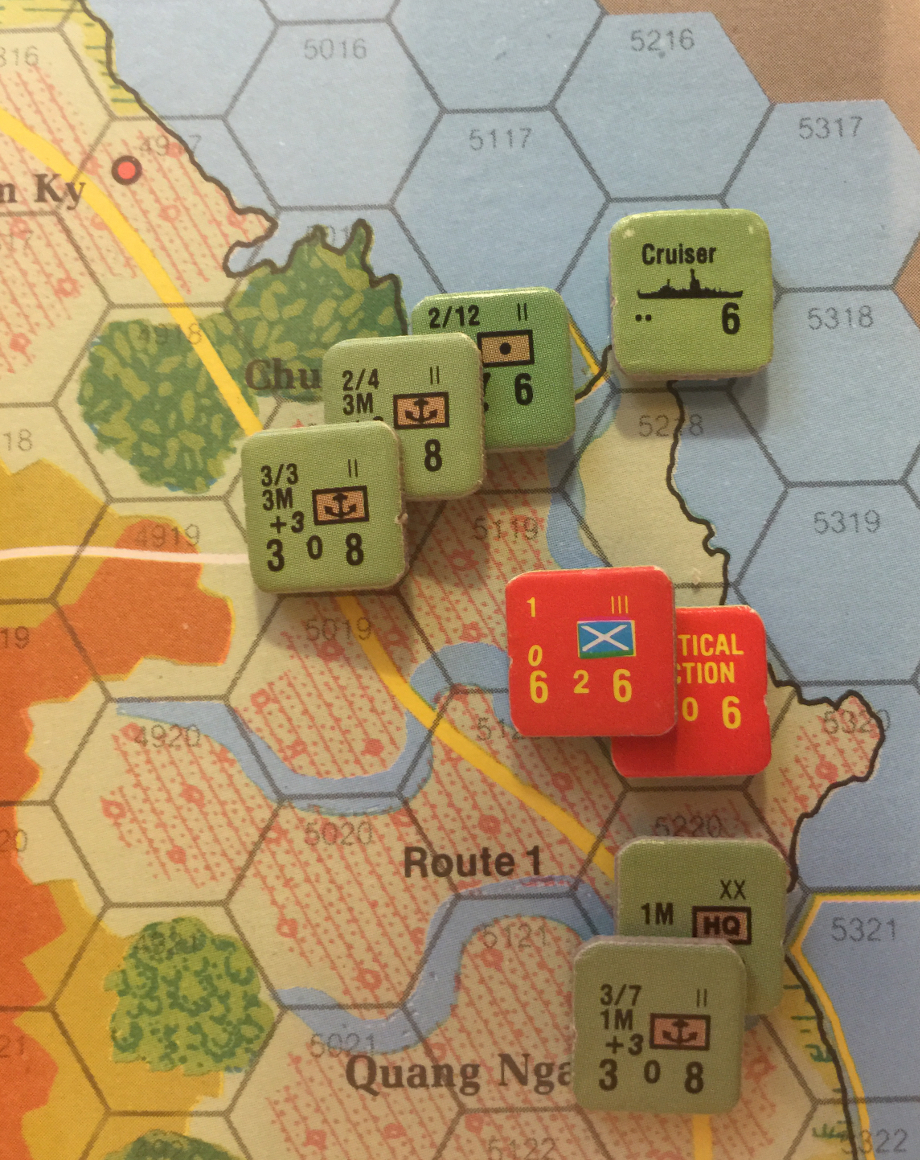
The bottom counter defines placement for the stack.
Special Rules
- NLF player may not conduct strategic movement.
- The Movement Point Allowance for VC units is reduced by 2 for all purposes including movement, alert, reaction, retreat and pursuit. The VC were used to fighting ARVN. The USMC demonstrated much more flexibility and speed than the VC had experienced with ARVN.
- The US player may not declare Free-Fire Zones. Free-Fire Zones are explained in Section 7.6, page 16 of the rule book. The idea is that artillery, naval and air support function at reduced effectiveness unless they are “free to fire” within a zone. These zones are declared during an operation’s Support Declaration segment.
- The US player wins if the VC regiment is dispersed, broken down, destroyed, or leaves the play area, but no US units are destroyed. If the US doesn’t win, the NLF wins.
Summer 1965
1. Support Phase
The US player indicates available air, airmobile, and riverine support on his record sheet, placing appropriate markers on the General Record Track.
As per set up, the US has 4 replacement points, 1 airmobile point, 4 air support points on the record track. The cruiser is placed in hex 5217.
(The NLF replacement marker is also set to 4.)
2. Special Operations Designation Phase
Both players note any units on holding or patrol operations.
Neither the US or the NLF put any units in holding or on patrol.
3. Strategic Movement Phase
The US player may conduct security operations and employ strategic and naval movement.
US player sees no need for strategic movement or security operations.
4. Operations Phase
Operation 1: NLF
A. Designation Segment
The phasing player choose the type of operation, which units participate, and the target hex of the units (if applicable).
The NLF chooses to split units and move, which is conducted as a Search and Destroy operation (Section 5, page 9). The political section targets 5020, 1st Regiment targets 5019.
B. Support Declaration Segment
The US player may assign air support, assign naval support or declare free fire zones.
Nothing for NLF here.
C. Movement Segment
Recall the scenario Special Rules reduce the NLF movement by two points, from 6 to 4.
The political section moves to 5020 expending all 4 movement points as follows. Moving to 5120 costs 2, one for moving into a cultivated hex, plus one for traversing enemy controlled hex. Moving from 5120 to 5020 costs another 2 points: 1 for moving into cultivated hex, plus another for crossing the river hex side.
The 1st Regiment pays the same 2 movement points to enter hex 5120, then another point to move to 5019, for a total of 3.
(Discrepancy with rule book example, which states that both units expend all 4 movement points.)
This completes the operation for the NLF forces; apply an OPS COMP marker to each unit.
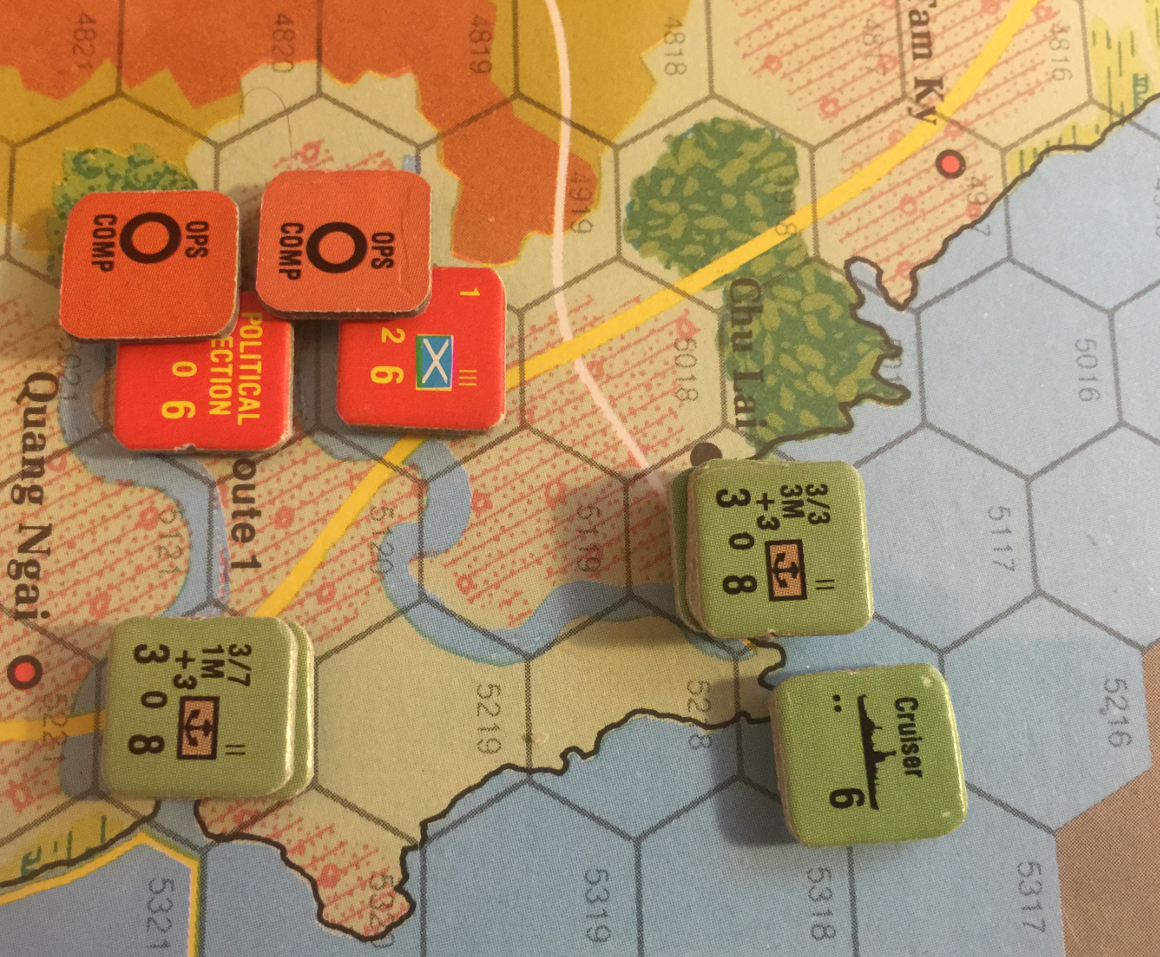
Operation 2: US
Since the NLF have no further operations this turn, the US is free to conduct an operation.
A. Designation Segment
The US chooses to send 3/3/3M on a Search and Destroy operation targeting hex 5020.
B. Support Declaration Segment
C. Movement Segment
3/3/3M moves from 5118 to 5119 expending 2 MP, from 5119 to 5120 expending 3 MPs (1 for cultivated, 1 for crossing river, 1 for eZOC), and from 5120 to 5020 expending a final 3 MPs (1 for cultivated, 2 for entering enemy hex). Since 5020 is a target hex, 3/3/3M does not need to reserve enough MPs to move out of 5020 (which would be at least 2MP).
(Discrepancy with rule book example, which states that 3/3/M only spends 6 MPs.)
EVERYTHING BETWEEN THE TWO HRULES NEEDS TO BE REWRITTEN AS THE EXPLANATION IN THE RULEBOOK IS INCONSISTENT: THE VC UNIT POSITIONS SEEM TO BE SWITCHED IN THE FIGURE WITH RESPECT TO THE EXPLANATORY TEXT.
Since the political section in 5019 is adjacent to the enemy 3/3/3M now occupying hex 5020, it gets a reaction move (Section 5.3, page 10), which is taken immediately. The unit moves to hex 4919 at a cost of its 4 MPs (1 to leave the USMC ZOC, 3 to enter mountain terrain).
Since the VC 1st Reg. in 5020 is a target unit, it does not get a reaction move.
D. Alert Segment (only in US operations)
However, the first responds with an Alert Movement during the Alert Segment, as it is a defender in a Search and Destroy operation (Section 5.2, page 9).
Alert d6 roll: 4.
Alert MP is 4 (roll) + 1 (terrain) - 2 (scenario) for a total of 3.
The unit moves south to 5018, expending 1 (cultivated terrain) + 1 (leave eZOC) + 1 (crossing river) for a total of 3 MPs.
(Question: is this the best move? If so, why? If not, what would be a better move?)
E. Combat Segment
3/3/3M decides to attack the VC unit adjacent in 5018. This unit is a VC political unit, which is removed from play (Section 10, page 18).
(Apparent discrepancy: this unit in the scenario diagram is show to be VC 1st Reg., but described as a political section in the playthrough.)
Since there are no further activities for 3/3/3M’s operation, this Search and Destroy operation is over (and we begin another round of operations.
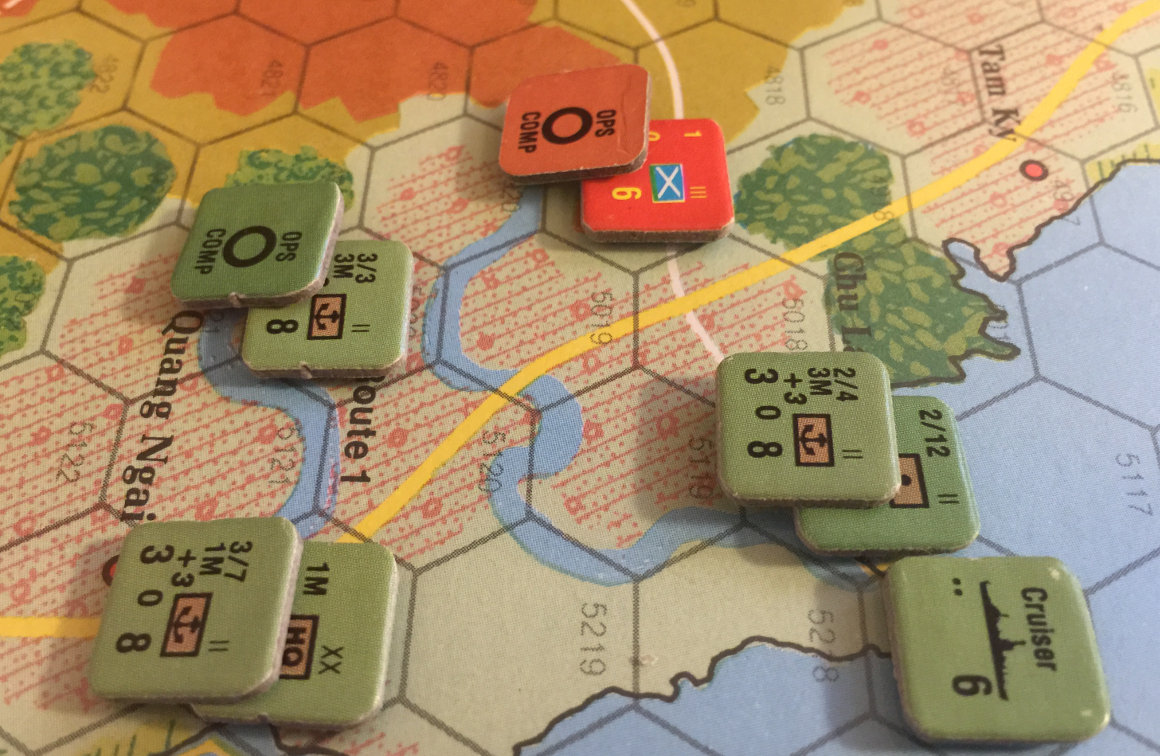
Operation 3: US
A. Designation Segment
Second Search and Destroy, targeting 4119. All ground units assigned.
B. Support Declaration Segment
All cruiser and air points are assigned. The cruiser fires all 6 points for interdiction (Section 7.4, p. 15 for Naval Gunfire, Section 7.5, p. 15 for Interdiction).
C. Movement Segment
- 2/12 to 5018: spend 1 MP for movement, 1 MP to enter ZOC.
- 2/4 to 5019: spend 4 movement to get through clear hex and into mountain hex, plus 1 to enter ZOC, plus 2 to enter enemy hex; 7 MP total.
- 3/7 to 4919: spend 8 MP, 6 for movement, 2 for ZOC. (Apparent discrepancy: the movement path shown in the example in the rules costs 11 MP as it crosses 2 river side hexes and is in enemy ZOC for 3 hexes.)
- 1M HQ to 5018: spend 4 MP movement, 1 MP ZOC.
The situation after USMC movement:
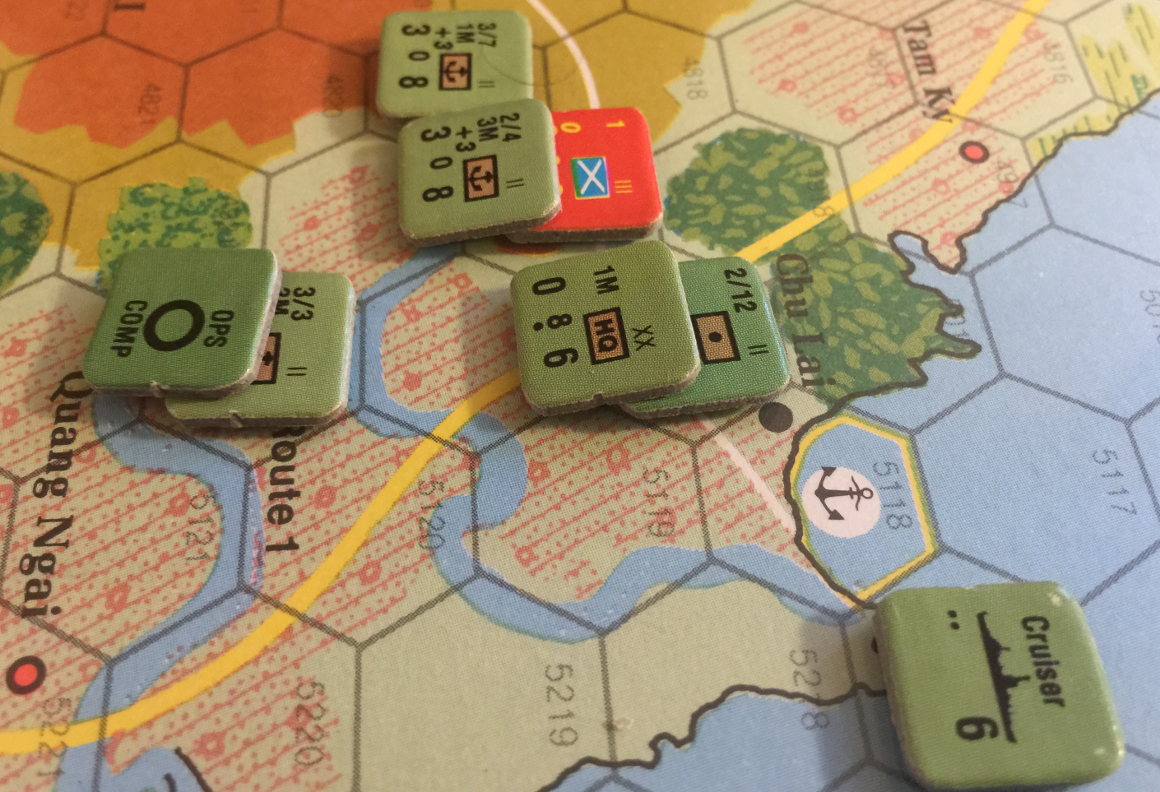
The NLF gets an Alert as it’s located in the target hex. Alert movement require computing the movement available to the unit and the cost to leave the target hex.
- Alert Movement available to the 1st Reg (Section 5.2, p. 10): roll d6 for result 2, add to 3 MP for mountain terrain, minus 2 MP per scenario results in 3 MP available for Alert Movement.
- Movement cost to leave: 1 MP to enter cultivated hex, 2 MP to leave hex occupied by enemy unit (from Terrain Chart on map), 2 MP from interdiction (Section 7.5, p. 15); 5 MP to leave 4919.
Since available is less then cost, the 1st Reg NLF. may not exploit Alert Movement and must remain in 4919.
E. Combat Segment
USMC attacks with all units:
- Ground: 3 + 3 = 6.
- Support: 4 from air, 8 from 1M HQ, 7 from 2/12 = 19. We need to halve this as the target hex is not a Free-Fire Zone, 19/2 = 9.5.
- Net: 15.5.
Defending:
- NLF: 6 ground, 2 organic artillery (Section 7.1, p. 14) equals 8.
- Net: 8.
Modifiers:
- Odds: 15.5/8 is on the 3:2 odds column, results in +1 DRM.
- Defending terrain is mountain, -3 DRM.
- Net DRM -2.
Casualties:
First, roll d6 for result 5 - 2 DRM net 3 for determining casualties.
- NLF: 6 ground strength + 9.5 enemy artillery (half strengt US total, see Section 7.6 Free Fire Zones, p. 16) = 15.5, use the right side of the 14-21.5 column to determine 2 casualties.
- USMC: 6 ground strength with 2 enemy artillery, use left side of column 8-13.5, determine 1 US casualty and loss of 1 air point. The air point loss takes effect on the next operation, the full value remains in effect for the remainder of the current operation (Section 7.3 Airpower, p. 15L).
Both factions take losses out of their respective replacement pools (Section 5.5, Casualties, p. 11).
There is no pursuit allowance for this roll.
F. Retreat Segment
Because the defending unit survived the attack, it’s allowed a full movement in any direction (Section 5.6 Retreat and Pursuit, p. 11R).
Hence, VC 1st Reg. retreats to 5019, expending 4 MPs: 1 MP to enter cultivated area, 2 for leaving enemy-occupied hex, and 1 to enter enemy (3/3/3M) ZOC. 2/12 Artillery and 1M HQ both have ground combat 0 and do not establish ZOCs (Section 3.1 Zones of Control, p. 7L)
Because 1st Reg.NLF moved adjacent to 3/3/3M, which is not participating in the Operation 3, 3/3/3M gets a reaction move and may move up to its full MPA (Section 5.3 Reaction Movement, p. 10L).
3/3/3M moves to block 1st Reg. NLF road access to the south by moving into hex 5120. This reaction movement does not trigger another reaction from 1st Reg. (Section 5.3 Reaction Movement, p. 10R).
Note that 5019 is now the target hex because of the retreat (Section 5.3, p. 12L).
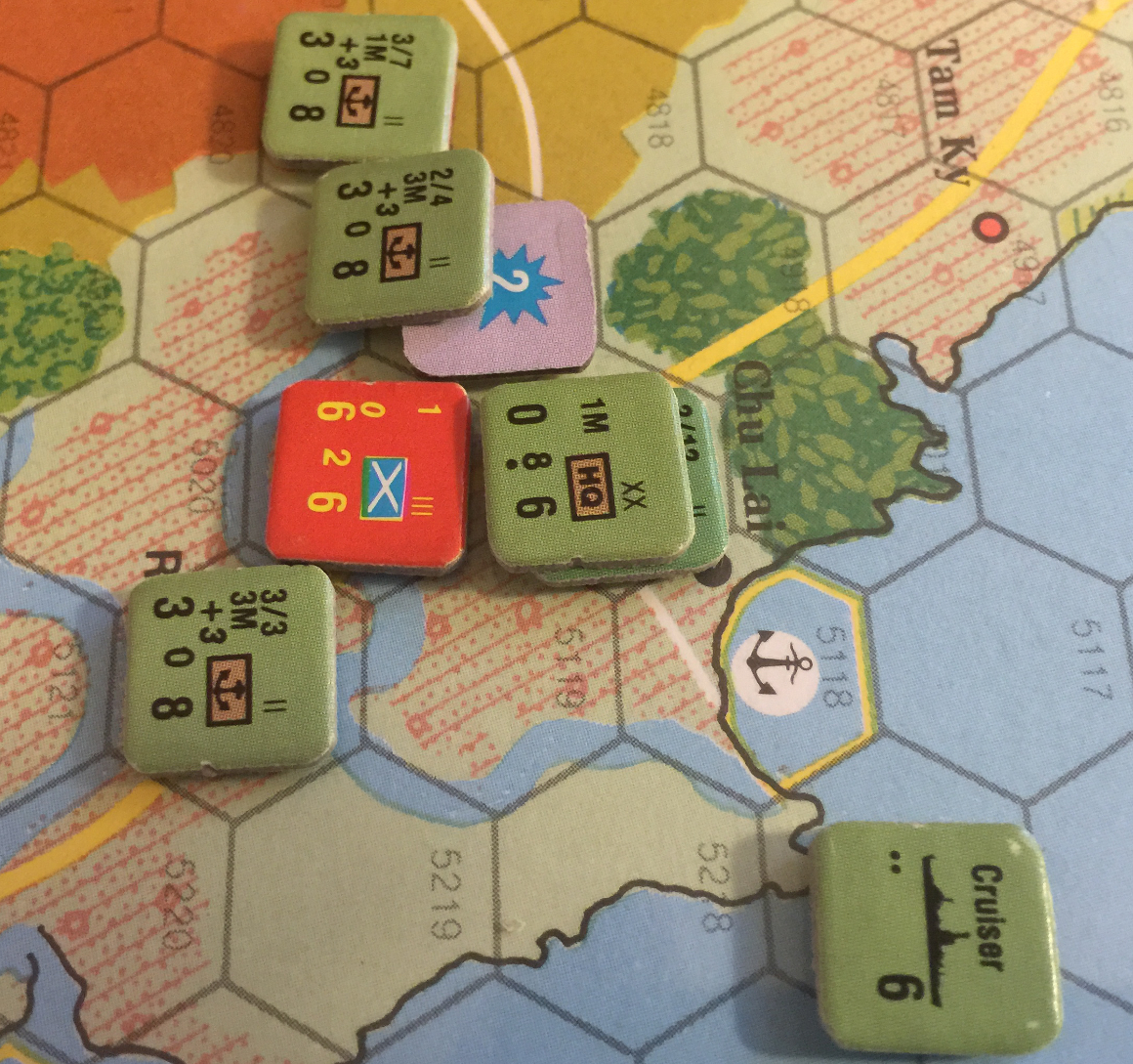
G. Pursuit Segment
1M HQ and 2/12 Artillery cannot pursue as they have no innate pursuit allowance.
As noted above, there is no pursuit allowance from combat results, so 2/4 and 3/7 have 3 pursuit points each.
- 2/4 chooses to remain in place.
- 3/7 goes airmobile (Section 8.1 Airmobile Movement, p. 16R) to move to hex 5020; 2 hexes at 1/2 each, + 2 MP for landing in enemy ZOC.
Because 3/7 is battalion-sized, Airmobilization costs 1 Airmobile point, so the Airmobile counter is decremented from 1 to 0.
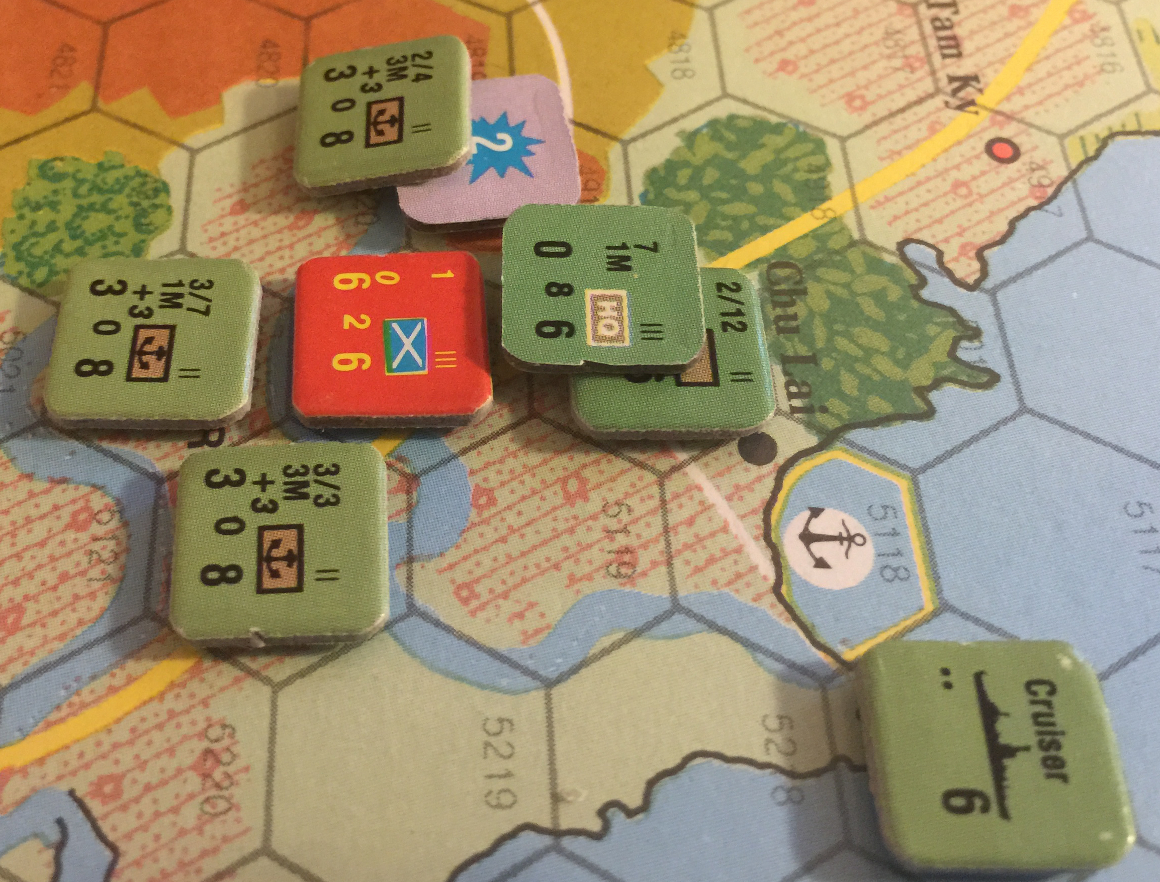
Note that the correct HQ unit was used in this image. Fortunately, the divisional HQ shown in other images did not affect game play for this scenario. Although if it had, the mistake probably would have been caught much earlier.
According the play through (p. 41L), the USMC units can choose to attack again. (Attacking after pursuit does not appear to be explicitly defined in the rules.)
Attacking units:
- 2/4/3M: 3 ground.
- 2/12 artillery: 7 support.
- HQ artillery: 8 support.
- Air: 4 support.
- Naval: 6 support.
Total attacker:
- Ground: 3.
- Support: 25/2, effectively 9.
- Net: 12.
Defender: 6 ground + 2 organic artillery. Net: 8.
DRMS:
- Odds: 3:2 yields +1 DRM.
- Terrain: cultivated, none.
- Pursuit remaining from 2/4/3M: 3.
- Net: +4 DRM.
Roll d6 for 3 + 4 DRM yields 7.
Casualties:
- NLF: 6 ground combat + 12.5 enemy support use column 14-21.5, row 7 is 3 losses for NLF.
- USMC: 3 ground + 2 enemy artillery use column 4-7.5, row 7 is 1 loss for USMC.
Three casualties are inflicted on NLF, which is one more than the replacements available. The NLF chooses to eliminate the which reaps 6 (ground strength) - 3 (casualties) 3 increase in replacements (Section 5.5 Casualties, p. 11R).
From the scenarion description, both USMC battalions may pursue up to 6 MPs: 3 for the combat result, +3 for the pursuit modifier. (This is unclear, the NLF unit was eliminated, why are we calculating pursuit MPA?)
H. Interdiction Removal Segment
Remove all interdiction markers from the map.
I. Continuous Operations Combat Segment
(Return to Segment and and repeat until neither player is able or willing to conduct an operation.)
No remaining NLF remain on the map, game is over.
5. Game Turn Indication Phase
Since this scenario is just one turn in length, we resolve victory conditions and the game is concluded.
After Action Report
I think this is the most involved of the games I’ve played so far (see collection), which includes the (possibly) beastly Central America.
It turns out (for me) that after working very carefully through the learning scenario, that it all makes good sense, at issue is there is a lot of “all.”
Specifically, the turn sequence is broken down into phases and segments, and some of them loop. For example, the operations phase has multiple segments, where fire and movement may occur in more than one of these segments, at the end of which another operation phase may start over (there’s the loop).
Compare to Central America with its relatively straightforward 16-19 phase turn (total, both sides). That’s a lot of phases, but still easy to track.
Having sat in several OCS games (but not yet played), the complexity for fire/movement/supply feels like CA < OCS < VN, where VN exceed OCS in complexity due to the arbitrary number and type of operations which may be conducted.